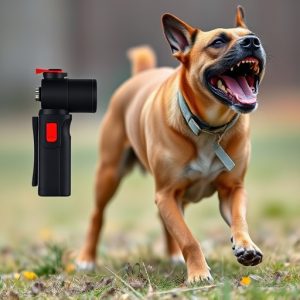Canine Pepper Spray: Benefits, Safety & Legalities for Mail Carriers
The OC Percentage (Oleoresin Capsicum concentration) in canine pepper spray is crucial for effective…….
The OC Percentage (Oleoresin Capsicum concentration) in canine pepper spray is crucial for effectiveness against aggressive dogs, ranging from 1% to 30%. Higher percentages are recommended for larger canines or increased risk scenarios. Mail carriers face unique challenges with dog encounters, making OC-based sprays a powerful tool for temporary disorientation and pain without causing lasting harm. Proper training and deployment techniques ensure safety and maximize protection for both carrier and dog. Legal constraints and regional regulations govern the use of such sprays, emphasizing the need for understanding local laws, especially regarding OC Percentage in canine pepper spray.
In the ever-evolving world of mail delivery, ensuring safety has become paramount. One innovative solution gaining traction is canine pepper spray, a non-lethal deterrent designed to protect carriers from aggressive dogs. This comprehensive guide explores ‘Understanding Canine Pepper Spray’ delving into key components like OC (Oleoresin Capsicum) percentage—a crucial indicator of its effectiveness. We weigh the benefits, safety measures, and legal aspects, providing insights for mail carriers considering this game-changing tool.
- Understanding Canine Pepper Spray: A Comprehensive Overview
- OC Percentage: What Does it Mean in Dog Spray?
- Benefits of Using Canine Pepper Spray for Mail Carriers
- Safety Measures and Training for Effective Use
- Legal Considerations: Is Canine Pepper Spray Legal for Mail Carriers?
Understanding Canine Pepper Spray: A Comprehensive Overview
Canine pepper spray, or dog spray, is a specialized defensive tool designed for use by mail carriers and other delivery personnel who may encounter aggressive dogs while on the job. Unlike traditional pepper spray, which typically contains capsaicin in concentrations around 2-5%, canine pepper spray is formulated with a much higher OC (oleoresin capsicum) percentage, usually ranging from 10% to 30%. This higher concentration makes it more effective against dogs’ sensitive olfactory systems, enabling mail carriers to deter and escape from potentially dangerous encounters.
The OC percentage in canine pepper spray plays a crucial role in its effectiveness. A higher OC content ensures that the spray stays in the air longer, lingers on fur and skin, and is more likely to be inhaled by the dog, causing temporary disorientation and pain. This delayed effect gives the carrier precious time to retreat or call for assistance. It’s important to note that while canine pepper spray can be a valuable tool, it should only be used as a last resort when facing an aggressive dog, and proper training in its use is essential for safety and efficacy.
OC Percentage: What Does it Mean in Dog Spray?
OC percentage, or Oleoresin Capsicum (OC) concentration, is a crucial factor to consider when choosing dog spray. It refers to the amount of capsaicin present in the spray, which is the active ingredient responsible for the burning sensation and subsequent deterrence in canine pepper spray. The higher the OC percentage, the stronger the spray’s effectiveness against potential threats.
This measurement ensures that dog owners are providing their pets with adequate protection. Typically, OC percentages in dog sprays range from 1% to 20%, with higher concentrations suitable for larger breeds or dogs facing more serious risks. Understanding this metric allows responsible dog owners to make informed decisions and select the right spray to match their needs and their dog’s capabilities.
Benefits of Using Canine Pepper Spray for Mail Carriers
Mail carriers face a unique set of challenges, from navigating unfamiliar routes to dealing with potentially aggressive dogs. Traditional deterrents like pepper spray can be effective, but canine-specific formulations offer several advantages. One key benefit is the OC (Oleoresin Capsicum) percentage in these sprays—typically much higher than standard civilian pepper spray. This ensures a more potent and longer-lasting effect when confronted by a menacing dog, giving carriers a crucial edge for self-defense.
Additionally, canine pepper spray is designed to be non-lethal and safe for both the carrier and the animal. The OC in these products causes temporary blindness, coughing, and discomfort, allowing mail carriers to escape safely without causing lasting harm. This humane approach not only protects individuals but also fosters a positive relationship between postal workers and dogs, ensuring a smoother and safer delivery process.
Safety Measures and Training for Effective Use
Mail carrier dogs, often tasked with navigating potentially hazardous situations, require specialized equipment for their safety and effectiveness. Canine pepper spray is a critical tool in their arsenal, designed to incapacitate aggressors temporarily while allowing the dog to escape or alert handlers. The key to its success lies in proper training and understanding the OC (Oleoresin Capsicum) percentage—the active ingredient responsible for the burning sensation and temporary blindness.
Training should encompass controlled exposure to simulate real-life scenarios, teaching the dog to recognize and respond appropriately to the spray’s effects. Handlers must be adept at deploying the spray accurately, aiming for the eyes and face where OC has the highest concentration. Regular practice ensures the dog remains calm under stress, enhancing its ability to protect itself and its handlers effectively. Additionally, maintaining a high-quality pepper spray with a potent OC percentage guarantees maximum impact during emergency situations.
Legal Considerations: Is Canine Pepper Spray Legal for Mail Carriers?
Mail carriers, like any other public servant, face a range of potential risks while on the job. The use of canine pepper spray has been suggested as a means to deter aggressive dogs and protect themselves and their mail. However, legal considerations come into play when discussing its use. Canine pepper spray, also known as dog spray or mace for dogs, typically contains capsaicin, the same active ingredient found in traditional pepper spray. The key difference lies in the OC (oleoresin capsicum) percentage, which refers to the concentration of capsaicin.
In terms of legal status, the use of canine pepper spray by mail carriers varies depending on local and state laws. Many jurisdictions have strict regulations regarding the carrying and use of pepper spray, including specific requirements for training, permits, and potential restrictions based on the OC percentage in the spray. Typically, higher OC percentages (e.g., 2% or more) are associated with law enforcement-grade pepper spray, which may be subject to additional legal oversight. It’s crucial for mail carriers considering this option to understand the local laws and ensure they operate within the boundaries set by their region.
The use of canine pepper spray, specifically those with an OC (Oleoresin Capsicum) percentage tailored for dogs, offers mail carriers a powerful tool for self-defense. By understanding the OC percentage and proper safety measures, professionals can enhance their safety while navigating potentially dangerous situations. Legal considerations must be carefully navigated to ensure compliance, but the benefits of this non-lethal option are significant in mitigating risks inherent to the job.


